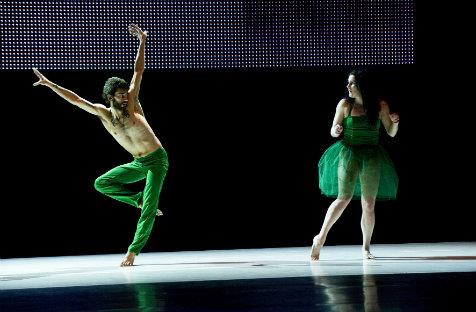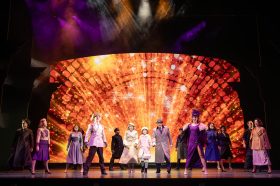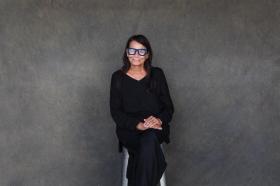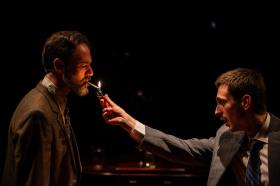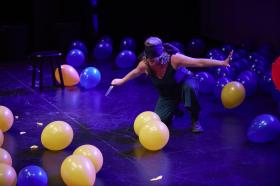Garry Stewart, artistic director of Australian Dance Theatre (ADT) since 1999, is a clever and innovative choreographer. He followed up his take on Swan Lake, Birdbrain, with G, which reinvents another classic favourite, Giselle.
Perhaps ‘reinvents’ is not quite the right word. As with Birdbrain, we have here an interpretation of the meaning and message of a classic, not a reinvented version of the original. The story of Giselle is told not in movement and mime, but by a series of snippets from the story flashed up onto an LED screen, high up on the back flat, while the emotional content of the story is presented by a constant, rotating procession of dancers from left to right, dancing alone or in pairs, sometimes dragging themselves or each other along the floor.
The dancers embody, as the blurb has it ‘central themes of hysteria, vulnerability, desire, gender, death and the afterlife’. Dancers did not play roles, but referenced them, so there was no one dancer that was Giselle. The universality of betrayal made all of them Giselle, all of them Albrecht, all of them nasty, spiteful Wilis. It was cleverly done. There was even a reference to Macbeth, another tale of betrayal, in the walking trees – or am I reading too much into that bit of silliness? Two dancers (one female, and later, one male) went topless, briefly, but I cannot account for that by any reference that leaps to mind. Really, it was quite unnecessary.
To say the choreography is athletic is an understatement. The program lists teachers of Pilates, Yoga, Meditation, and Breakdancing. The first three have long been accepted as worthwhile adjuncts to a dancer’s training, but a company with a regular breakdance instructor is a new one on me. But less than ten minutes into the performance, I could see why one was needed. The performers hurled themselves to the floor over and over again, performing gymnastic feats that made me fear for their safety.
When they were on their feet, they drew on their classical training to show us the intense drama of the story. References to the original choreography, especially the ballottés of the act one pas de deux, reminded us of our debt to Coralli. Similarly with snippets from Adam’s original music, set within a driving electronic score by dancer-turned-composer/sound designer Luke Smiles.
Dance Education is an important part of ADT’s brief, and the audience was largely composed of dance students. I would go so far as to say the ballet was aimed at teenagers, for when else does life seem so intense and so bizarre? We get used to it, accommodate it, as we get older, but as teenagers we gobble up intensity like hungry dogs. Stories about young people and their emotional trials appeal to teenagers, and rightly so; hence the popularity of Romeo and Juliet in all its many manifestations.
Yet my companion and I, as adult viewers, experienced the soundscape and the constant frenetic movement as somewhat too intense, and found ourselves wishing G was over long before it actually ended. Intensity for its own sake loses appeal once we are grown up, for we recognise it as a second-hand emotion, one that to be meaningful, must ride on the back of a primary emotion – love, hate, betrayal, anger, or what have you – and to portray those without context is meaningless. Far from universalising the Giselle story, which I imagine was the intent, G trivialised it.
Certainly there is intensity in Giselle, but the intensity hinges on the characters and story. By the end of a well-performed first act, I am invariably in tears, not just for Giselle, but for every young woman who has ever been abandoned by a lover. G, on the other hand, amazed me, but it did not make me cry.
It did, however, make me worry about the dancers’ bodies in 40 or 50 years’ time, when arthritis, the old dancers’ enemy, charges them a high price for all those rolls and contortions. So it’s Giselle with Gym, but not as we know it. Rather it is a commentary on the classic, and is well worth seeing, but I must admit that do not want to see it again.
Rating: 3 stars out of 5
Australian Dance Theatre presents
G
Artistic Director and Choreographer: Garry Stewart
Set & Costume Designers: Daniel Jaber and Gaelle Mellis
Sound Designer: Luke Smiles
State Theatre Centre, Perth
3 – 7 July
